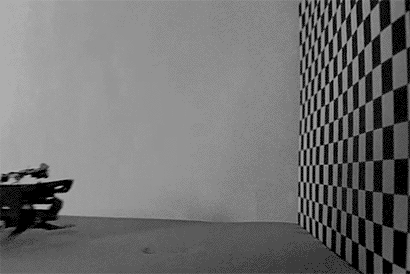Cockroach-inspired robot is no crash-test dummy
DASH robot mimics cockroach's ability to use the energy of its crash to propel itself up and over obstacles

February 16, 2018
UC Berkeley footage of cockroaches crashing into a wall and the DASH robot, which mimics the roach's ability to use the energy of the crash to propel itself up and over obstacles. (Video courtesy of AAAS)
Some toddlers never seem to learn that if you run too fast you’ll bump your head.
Skittering cockroaches bump their heads a lot too, but they’ve learned to embrace it, using the collision energy to propel themselves up and over obstacles.
UC Berkeley researchers have taken a lesson from these creepy crawlies and built a robot called DASH that uses the momentum of a head-on crash to tip itself upward to climb a wall.
Kaushik Jayaram, who earned his Ph.D. in the UC Berkeley lab of Robert Full, discovered how these rapid running roaches transition up a wall. Inspired by these creatures, Ron Fearing’s engineering team modified a palm-size robot with a soft, roach-like exoskeleton and six legs is named the Dynamic Autonomous Sprawled Hexapod, or DASH. And it has no sensors or onboard-computer to tell it what to do.
“Their bodies are doing the computing, not their brains or complex sensors,” Jayaram told the New York Times.
 DASH can now scurry up an incline, if equipped with gecko toes – sticky pads that Full and Fearing has also investigated and adapted for robots – they may one day become as nimble as a cockroach.
DASH can now scurry up an incline, if equipped with gecko toes – sticky pads that Full and Fearing has also investigated and adapted for robots – they may one day become as nimble as a cockroach.
Their study appeared this week in the Journal of the Royal Society Interface.
Roaches are different from babies in that roaches weigh so little that they don’t sustain damage when slamming into a wall. Their flexible and soft exoskeleton acts like a car bumper when they hit a wall at a typical running speed of about one meter (three feet) per second, or some 50 body lengths per second. They can go from horizontal to vertical in about 75 milliseconds.
Jayaram and Full discovered, however, that anything weighing over about one kilogram, or 2.2 pounds, would be less likely to do this. That covers just about all running toddlers.
The new work, Full says, “shows that small robots can be built with simple, robust, smart bodies to safely bump into obstacles instead of using complex and expensive sensing and control systems. Our research has already inspired collision safe flying robots using a compliant exoskeletal cage.”
“Relying on the mechanical control offered by soft exoskeletons represents a paradigm shift for understanding the control of small animals and the next generation of running, climbing and flying robots where the use of the body can off-load the demand for rapid sensing and actuation,” the authors wrote.
Other co-authors of the study were graduate students Jean-Michel Mongeau and Paul Birkmeyer and undergraduate Anand Mohapatra. Full is a professor of integrative biology, while Fearing is a professor of electrical engineering and computer sciences.